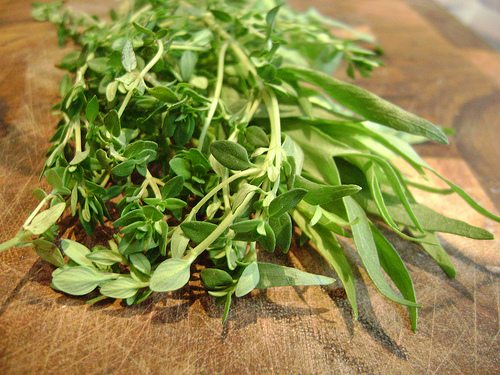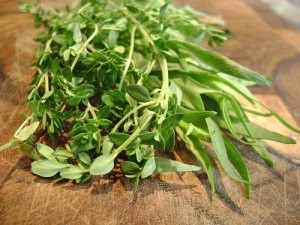Tarragon and Thyme

 Question from Dee:
Question from Dee:
This is my first garden this year so I really don’t know what I Am doing.I buy tarragon and Thyme every year and put it in pots.I live in zone 9 and I planted some french tarragon and varigated thyme in my garden and it gets full sun about 12 hours and day.Well my french tarragon the leaves got very little and it looks terrible it was ok till the end of june.My varagated thyme as soon as I plnted it it was not varigated anymore and it was ok till the end of june.Some of the stems are bare and woody.What I decided to do is pull it up and put them in pots in the shade.Can you help what you think may be wrong with them.
Answer from Pat:
Most herbs are easy to grow but variegated thyme is a little less long-lived than common thyme (Thymus vulgarus.) If you live in a very hot place your herbs would appreciate light shade rather than full sun. Thyme likes deep, light, well-drained soil, it doesn’t grow well in heavy clay. If you have clay soil, amend it well with organics before planting. Thyme prefers deep watering so that it dries out between irrigations, but I find that creeping types of thyme need more water and moister soil than most people think.
Growing creeping thymes between stepping stones is one of the best ways, keeping roots cool, moist but not overwatered. Almost any type of thyme grows best next to a rock that it can nestle its roots under. In sun that bakes as long as your query suggests, a nice big, cool rock nestled into the ground next to the plant would do wonders. Clip the plant back as it grows. This will make it put out fresh growth and stay bushy. Yes, you can grow thyme in pots filled with a good quality of potting soil, but choose one large enough for roots. About one foot across should do the trick.
True French tarragon (Artemisia dracunculus) needs somewhat richer soil than thyme but prefers it to be well-drained. It can even take some fertilizer to keep it growing. Yes, this plant also can be grown with a little shade and does well in pots. I have had luck growing it in the garden and also pots. If you have the real French tarragon, it tastes good in cooking and clip it back to keep it branching and growing. Mexican tarragon (Tagetes lucida) lacks the real taste of tarragon. It doesn’t taste as good. All tarragon dies to the ground in winter. In mild zones it usually rots and doesn’t come back the following year. With as much heat as evidently your plants have had, it might have suffered from root rot. I think both your plants might have been victims of heat. Rock gardens are ideal for growing herbs.
Since you are new to gardening, please don’t become discouraged, but try to keep you spirits up. All of us have failures sometimes and some plants die no matter what. So keep on trying, experimenting, and learning by experience. New gardeners often fail to do proper soil improvement prior to planting and sometimes they either over or under water plants, and over or under fertilize them. Eventually you will get the hang of the whole subject and have success.


I live in Southern California, having grown cucumbers for almost a decade.
Now I got a problem I never faced before.
I have bought Marta Stewart seeds and grew a number of plants without knowing they are gynoecious.
They are now big and healthy, with a plenty of large yellow flowers, which dry and fall off without giving any kukes.
I found in Google that they need “a pollinizer variety interplanted.”
To make things worse, we have a deficit of bees in our area.
Could you explain what it means and how to do it?
I tried to do hand pollination with a brush, but there were no results.
Please help! I need to do something right now.
Gynoecious cucumbers are hybrids that bear only female flowers, but each packet of seeds should contain seeds of male plants. Why choose to grow these cucumbers when it’s so much easier to grow a really flavorful, delicious hybrid variety that’s easy-to-grow, such as ‘Burpee Burpless’? If you have no bumble bees or honey bees for pollination, you can take a small watercolor type paint brush, sable is best and twirl it in the center of the male blossom and then visit the female blossoms in the same way. I sometimes get fed up with all the new things people do with plants that make them more complicated to grow and not necessarily any more flavorful than older, tried-and-true varieties. Gynoecious cucumbers were developed to be more productive, not necessarily to be better tasting. Parthenoecious cucumbers were developed without seeds so they could be greenhouse grown without pollination.